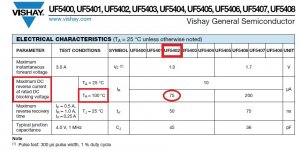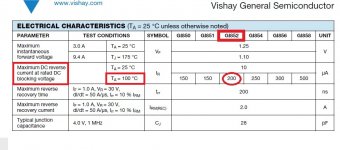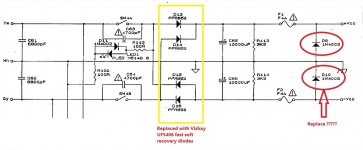Hi All,
I have a Mission Cyrus 2 amp and while servicing it (recap) I've found that the rectifier diodes (probably) have been replaced in the past as there are 2 GI852 (fast recovery 3A diode) and 2 8827 diodes (can't find any info about it).
according to the service manual there should be 4 PFR852 (3A rectifier diode which have the same specs as the GI852).
I've found an ultrafast soft recovery diode, the Vishay UF5402 to replace the rectifier diodes in my Cyrus 2 amplifier.
looking at the datasheet of the UF5402 it seems that there is one difference between the 2, I would like to know please how important is the marked parameter in the attached datasheets?
Can the UF5402 diode safely replace the 2 GI582 and the 2 unknown 8827 diodes in my amplifier?
Thanks
I have a Mission Cyrus 2 amp and while servicing it (recap) I've found that the rectifier diodes (probably) have been replaced in the past as there are 2 GI852 (fast recovery 3A diode) and 2 8827 diodes (can't find any info about it).
according to the service manual there should be 4 PFR852 (3A rectifier diode which have the same specs as the GI852).
I've found an ultrafast soft recovery diode, the Vishay UF5402 to replace the rectifier diodes in my Cyrus 2 amplifier.
looking at the datasheet of the UF5402 it seems that there is one difference between the 2, I would like to know please how important is the marked parameter in the attached datasheets?
Can the UF5402 diode safely replace the 2 GI582 and the 2 unknown 8827 diodes in my amplifier?
Thanks
Attachments
Hi again,
I replaced the 4 D13-16 diodes (attached drawing) with Vishay UF5406 fast soft recovery diodes now I noticed that there are 2 more 1N4002 diodes just after the smoothing/reservoir capacitors , is it a good idea to change those aswell?
If so so which one that mentioned below would be the best.
I have 3 different diodes that I can put there:
1. Vishay UF5406 6A fast soft recovery diode
2.Vishay UF5404 4A fast soft recovery diode
3. Vishay SB2H100 2A schottky diode
Thanks
I replaced the 4 D13-16 diodes (attached drawing) with Vishay UF5406 fast soft recovery diodes now I noticed that there are 2 more 1N4002 diodes just after the smoothing/reservoir capacitors , is it a good idea to change those aswell?
If so so which one that mentioned below would be the best.
I have 3 different diodes that I can put there:
1. Vishay UF5406 6A fast soft recovery diode
2.Vishay UF5404 4A fast soft recovery diode
3. Vishay SB2H100 2A schottky diode
Thanks
Attachments
The UF5402 has a better spec for PIV leakage current, so no issue in that regard as a replacement. The UF5402 seems to be the most appropriate replacement imho.
Using the UF5406 as a replacement is a poor choice imho, as the on-voltage spec is higher and the part will get hotter, and it is not an equivalent part to OEM device. Why did you choose that part?
There is no need to change D9/D10 if they are the original parts - their function has no operational performance issue that could be improved on.
Using the UF5406 as a replacement is a poor choice imho, as the on-voltage spec is higher and the part will get hotter, and it is not an equivalent part to OEM device. Why did you choose that part?
There is no need to change D9/D10 if they are the original parts - their function has no operational performance issue that could be improved on.
Using the UF5406 as a replacement is a poor choice imho, as the on-voltage spec is higher and the part will get hotter, and it is not an equivalent part to OEM device. Why did you choose that part?
Which part will get hotter? the diodes?
If so why? isn't the maximum "on-voltage" the upper limit of the diode to pass voltage before it fails?
The only reason that I used this diode as I had it in hand at the time
A diode typically gets heated up by dissipating power when it is on (forward biased), with the level of power being the current multiplied by the 'on-voltage'. You are using a diode model that has a higher 'on-voltage' than the OEM part.
The UF540x range datasheet shows two groupings - one group is the lower voltage rated parts, and the other group is the higher voltage rated parts. It is likely that the manufacturer just makes two parts, and uses quality control to sort or bin the parts to the actual part numbers shown. UF5406 is in the higher voltage group, and so is likely to have a higher on-voltage (for the same current level) than a part from the lower voltage group - that is consistent with pretty much any range of power diodes.
You have misinterpreted the datasheet spec for 'maximum instantaneous forward voltage'. That spec relates to the 3A current test condition, and there is a footnote identifying the test as a pulse test, that effectively keeps the diode die temperature at its ambient level (as the forward voltage will fall for higher die temp). So the spec value for 1.7V identifies the max rated voltage that the junction will reach for 3A at the ambient temp of 25C.
The UF540x range datasheet shows two groupings - one group is the lower voltage rated parts, and the other group is the higher voltage rated parts. It is likely that the manufacturer just makes two parts, and uses quality control to sort or bin the parts to the actual part numbers shown. UF5406 is in the higher voltage group, and so is likely to have a higher on-voltage (for the same current level) than a part from the lower voltage group - that is consistent with pretty much any range of power diodes.
You have misinterpreted the datasheet spec for 'maximum instantaneous forward voltage'. That spec relates to the 3A current test condition, and there is a footnote identifying the test as a pulse test, that effectively keeps the diode die temperature at its ambient level (as the forward voltage will fall for higher die temp). So the spec value for 1.7V identifies the max rated voltage that the junction will reach for 3A at the ambient temp of 25C.
Thank you very much for the detailed explanation.
As I have few UF5404 (the same group with the UF5402 in the datasheet) in hand would it be better to use it than the UF5402? would it make any difference?
Thanks
As I have few UF5404 (the same group with the UF5402 in the datasheet) in hand would it be better to use it than the UF5402? would it make any difference?
Thanks
It's reasonable to think that the UF5402 and UF5404 would have a similar on-voltage, and as such each of them would perform the same in your application, as both of them meet or exceed the OEM part's PIV rating. Without testing them for on-voltage then that isn't confirmed.
Perhaps best to take a look at say the Vishay datasheet before making flippant comments. That amp has a large toroid 31-0-31Vac rectified in to 10,000uF bulk caps per rail, and 4A DC feed fuses. The higher voltage rated UF540x have 50-80% higher on-voltage at rectifying current levels above 3A.Hair splitting.
It won't make à différence.
That amp has a large toroid 31-0-31Vac rectified in to 10,000uF bulk caps per rail, and 4A DC feed fuses. The higher voltage rated UF540x have 50-80% higher on-voltage at rectifying current levels above 3A.
I've replaced the UF5406 with the UF5402, I don't know if it's related or maybe it's just me but now it feels that there is a little less bass and "punch" from the amplifier, does it make any sense?
Is it possible that changing the rectifier diodes have this kind of effect or is it just my imagination?
- Home
- Amplifiers
- Power Supplies
- Mission Cyrus 2 rectifier diodes replacement


